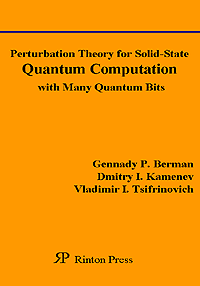|
 
A quantum computer is expected capable to
solve a vast range of mathematical and physical problems
much faster than a classical computer. In order to be
useful, the register of a quantum computer must contain
a large number of qubits. Numerical simulations of
quantum dynamics of a many-qubit quantum computer (for
optimization of parameters, benchmarking, and
architecture design) requires diagonalization of
exponentially large matrices or integration for a long
time of an exponentially large system of coupled
differential equations.
In this
book, a theoretical approach is presented, which solves
the above problem by using a quantum-mechanical
perturbation theory. The
perturbation theory is based on small parameters that
naturally appear in the system. The results of
numerical simulations are widely used to support the
theoretical propositions.
It is
demonstrated how to simulate simple quantum logic
operations and quantum protocols involving a large
number of qubits (up to 2000). It is especially useful
for minimizing the effects of most types of errors
encountered in solid-state quantum computers.
Implementations of quantum algorithms are demonstrated
in spin systems, quantum dots, and superconducting
systems. Almost all results of the book are derived from
the first principles.
This book is useful for scientists,
engineers, and students who are interested in quantum
computing. |

